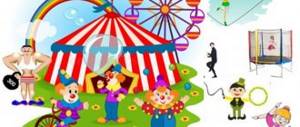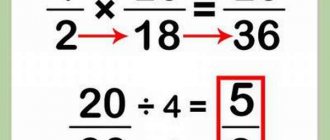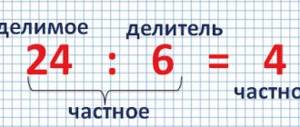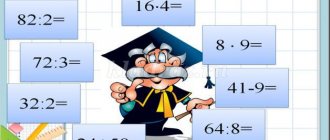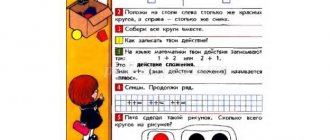Download material
so UNT / Lesson developments / Lessons in Mathematics
Notes for the mathematics lesson “Number and figure 3. Triangle” 1st grade
09/12/2015 4459 506 Zhuk Yulia Viktorovna Purpose of the lesson: to introduce the number and number 3, composition and expression. Objectives: Show how to obtain the number 3 by separating similar objects from a group according to two distinctive features. Learn to write the number 3. Develop attention, thinking, speech. Foster a love for animals and the environment. Foster cognitive activity and independence. Lesson type: learning new teaching methods: reproductive, practical, comparative. Forms of training: exercises, training tasks Types of knowledge control and feedback: individual, frontal survey. Equipment: tables, notebooks with a printed base, counting material, fans, presentations: “Funny Counting”, “Writing Numbers”.
During the classes
I. Organizational moment. II. Updating knowledge. Verbal counting. (Working with fans) Counting in a “chain” from one to 10 in forward and reverse order. Show on the fans the previous number, the next... Name the “neighbors” of the numbers 4, 6, 9. Which number comes first when counting?” [One.] What number comes after it?” (Two.) Name the numbers in order from 1 to 5, from 3 to 6, from 7 to 10, etc. Exercises to compare two groups of objects; equalization (two ways). Open 5 red circles on your strip in one row, and 6 blue circles in the second row. —Which circles are bigger: red or blue? - There are fewer of them. How can I make the number of red and blue circles equal?
“Fun tasks”
Our cat has five kittens, sitting side by side in a basket. And the neighbor's cat has three! So cute, look! Help me count, what is three and five?
Seven geese set off on their journey. The two decided to rest. How many are there under the clouds? Count it yourself, children.
The apples in the garden are ripe, We managed to taste them, Five ruddy, pouring ones, Two with sourness. How many are there?
The hedgehog brought three apples from the garden. He gave the most rosy thing to Belka. The squirrel received a gift with joy. Count the apples on the hedgehog's plate!
III. New material.
1. Introduction of number and figure 3. Three is a snake charmer. He came out with his pipe. A snake dances in front of him - the tail is hooked, the neck is arched. Look at the snake - It’s the number three! V. Danko
He has colored eyes, Not eyes, but three lights, He looks at me with them in turn. Traffic light (Conversation about traffic rules)
2. Setting the goal of the lesson. — Formulate the topic of the lesson.
Before us is the number three. Take a closer look. Draw, my friend, two flower petals. The petals are looking to the right: Don’t hold your hands. Stop the pencil! The result is number three! OR And look at this, the number three appears. Three - the third of the icons - Consists of two hooks.
— What is connected with the number 3 in your life? — What do you know about the number and figure 3? — What works of art are associated with the number 3?
How many months are there in winter, In summer, in autumn, in spring, How many eyes do traffic lights have, Bases on a baseball field, Edges on a sports sword And stripes on our flag, No matter what anyone tells us, Numbers know the truth...
3. Familiarity with the method of obtaining the number 3 is based on the children’s performance of practical work. The teacher asks the student to place one blue triangle and one red triangle on the typesetting canvas. - How many triangles are there? — Place a card next to it indicating the number of triangles. - Add another triangle to these triangles. - How many triangles are there? “How did you get three triangles?” A similar practical exercise is performed with children sitting at the sledge under the dictation of the teacher. - Count from 0 to 3 and back. Pay attention to the location of the number 3 relative to the numbers 0, 1 and 2, the designation of the number 3.
IV. Physical exercise.
The sun looked into the crib... One, two, three, four, five. We all do exercises, We need to sit down and stand up. Stretch your arms wider, One, two, three, four, five. Bend over - three, four, and jump in place. On the toe, then on the heel. We all do exercises.
V. Consolidation. 1. Working with the textbook (pp. 31-32). Tasks 1, 2 and 3. Based on the plot of the picture, children explain how the equalities 2+1=3, 3-1=2 are composed. Children obtain the number 3 in three ways: by counting objects, by adding in the process of measuring length. The elements of triangle and angle are repeated. Task 4. The numbers 2 and 3 are compared. Children read entries using the signs “greater than” and “less than”. Task 5. A suitable drawing is selected for the recording. NZ. You should compare the combs, eyes, beaks, flowers, petals, wings, and legs of chickens. Etc. In the first row on the left and in the second row in the middle, the chickens are the same.
2. Work in a notebook (p. 24). Task 1. Students find the numbers corresponding to the number of toys and connect them with a line. Task 2. Practicing the ability to write the number 3 and repeating the writing of the numbers 0, 1, 2 and action signs. Task 3. Find and circle the indicated lines in the pictures.
VI. Lesson summary. — What topic did you study in today’s lesson? — What does a person have to do with the number 3 and the number 3? — Guess the riddle: “Three people plow with one plow?” - What does this riddle mean? — What time does the clock show?
See the downloadable file for the full text of the material.
The page contains only a fragment of the material.
